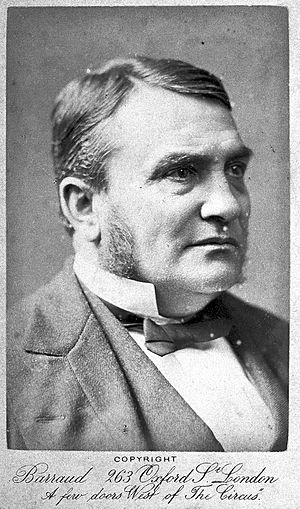John Wood (surgeon) facts for kids
Quick facts for kids
John Wood
|
|
|---|---|
 |
|
| Born | 12 October 1825 |
| Died | 29 December 1891 (aged 66) |
| Occupation | Surgeon |
John Wood (12 October 1825 – 29 December 1891) was an important British surgeon. He worked at King's College Hospital in London. Wood was a specialist in treating hernias, which are when an organ pushes through a weak spot in a muscle or tissue. He also studied and supported new ideas about keeping things clean during surgery. These ideas were first developed by Joseph Lister, who was a pioneer in antiseptic surgery.
Contents
Who Was John Wood?
John Wood was born in the United Kingdom on October 12, 1825. He became a very respected surgeon. His work helped improve how doctors performed operations. He was known for his careful research and for teaching others.
Early Career and Studies
Wood became a Fellow of the Royal College of Surgeons of England in 1854. This meant he passed special exams to show he was a skilled surgeon. He won the Jacksonian Prize in 1861 for his important research. This award showed his talent in surgical studies.
Contributions to Medicine
John Wood was a leader in his field. He taught anatomy and surgery to many students. He also helped examine new doctors. He was a member of the Royal College of Surgeons' council, which helped guide the college. In 1885, he became the Vice-President.
Wood was also elected a Fellow of the Royal Society in 1871. This is a very high honor for scientists. It showed that his work was important to the world of science and medicine. He gave a special talk called the Bradshaw Lecture in 1885, where he shared his knowledge about antiseptic practices.
Later Life and Legacy
John Wood also worked as an examiner at important universities like the University of London and the University of Cambridge. He was also the president of a branch of the British Medical Association. He was even an honorary member of the Swedish Medical Society, showing his international recognition.
Wood passed away on December 29, 1891, in Kensal Green, London. He is buried in Kensal Green Cemetery. His work helped make surgery safer and more effective for many people.
Images for kids


